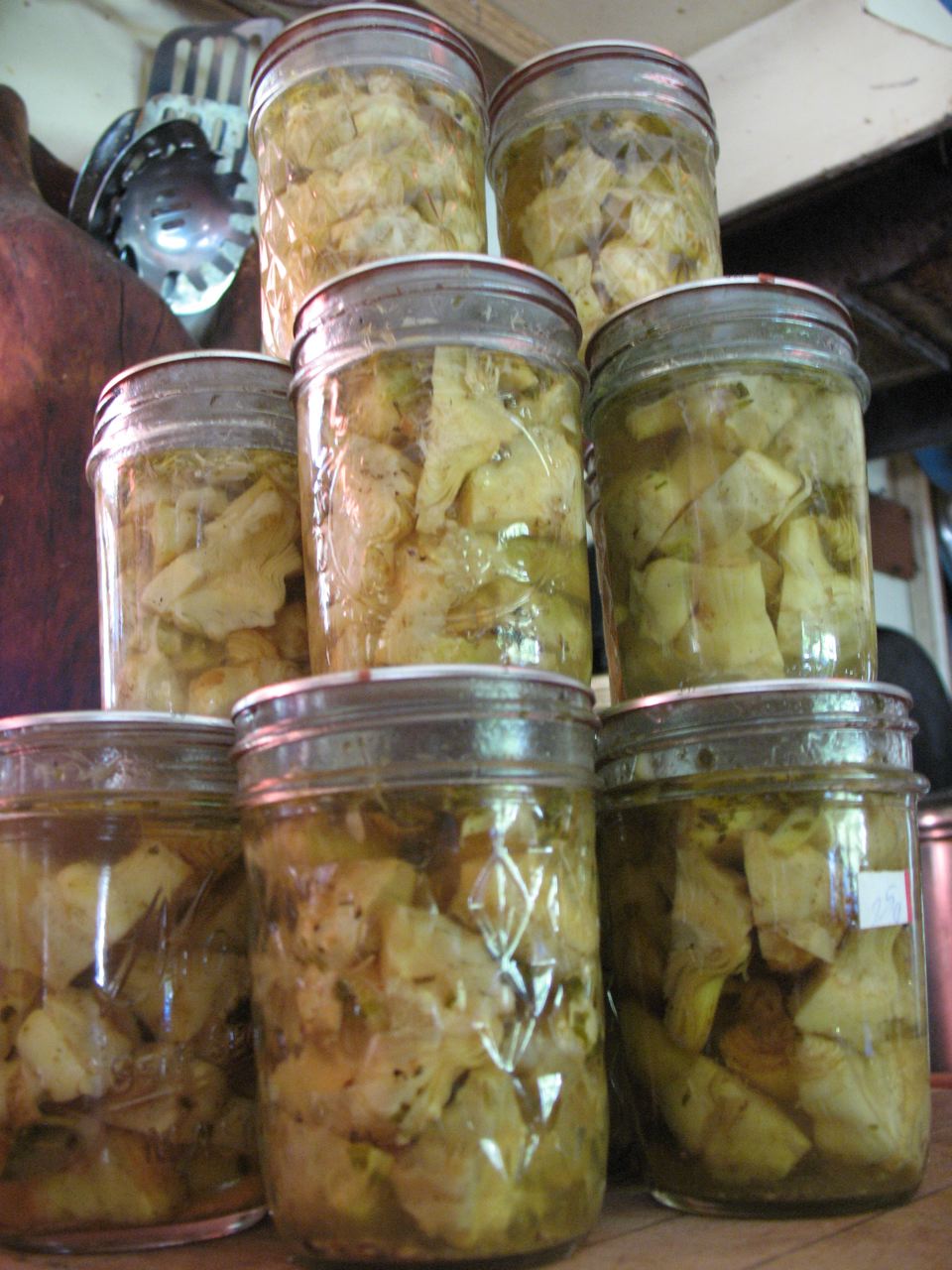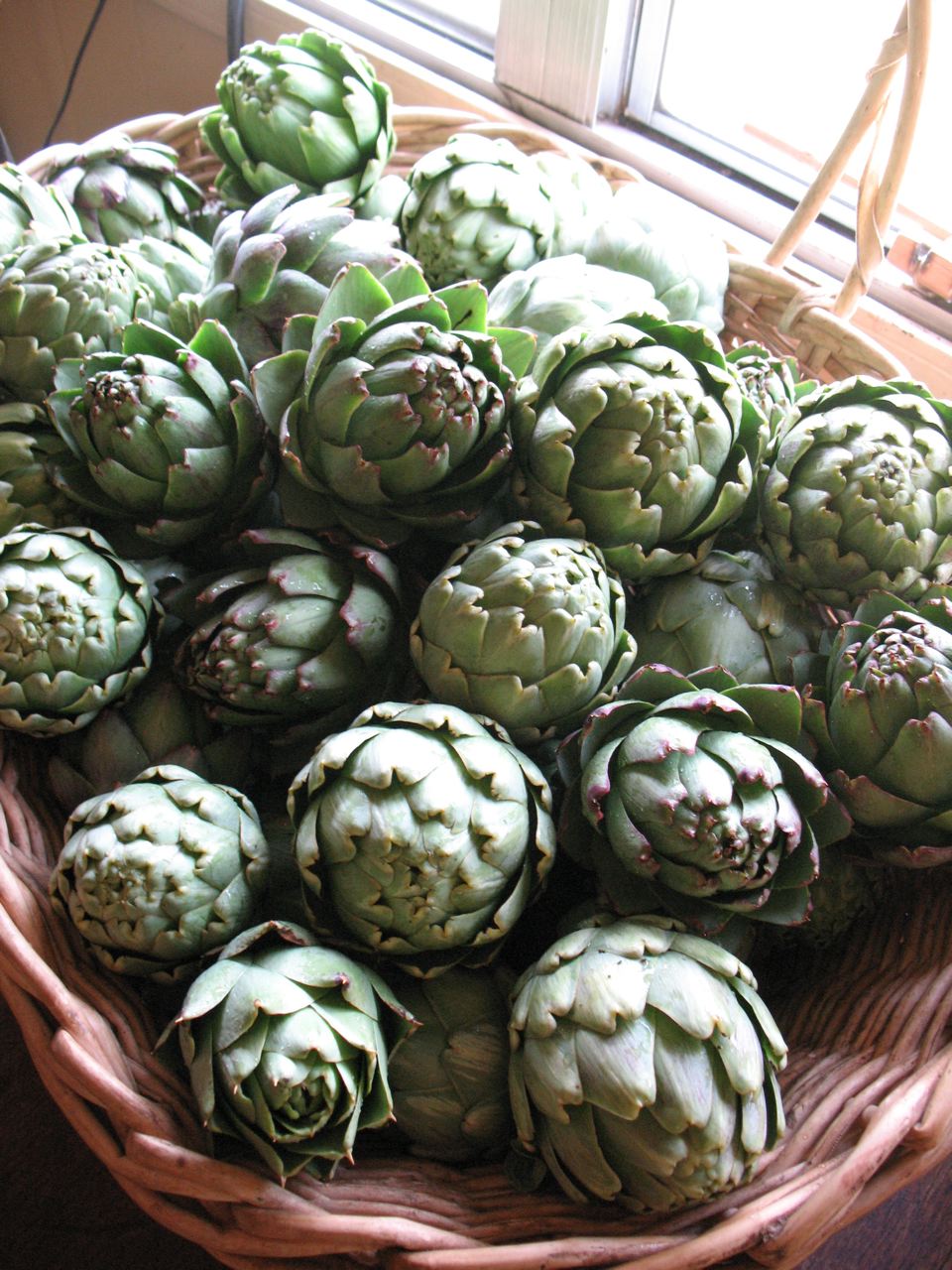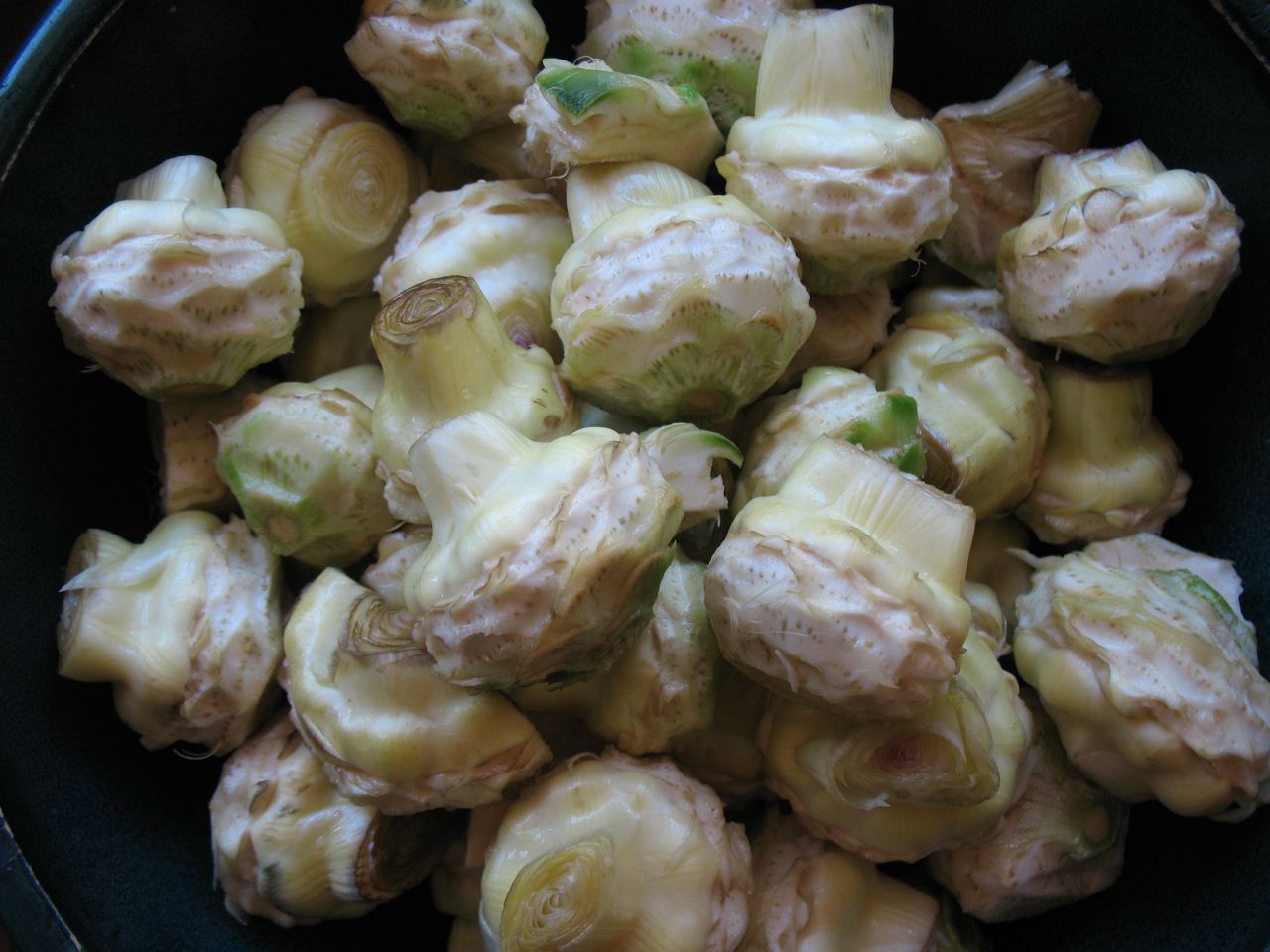In season I eat a ton of artichokes. I pick them young so the hairs (the choke) are soft and edible. I don't envy anyone their store bought chokes so overgrown that they require shaving before consumption. I have quite a few plants and however many I harvest at a time it's never really enough, because any that aren't just eaten steamed will be pared down to only their tenderest parts and canned up as marinated artichoke hearts. The plants in my garden, a row of them, are 7 feet tall at least, maybe 8. They sprout from dormant roots with the fall rains. They grow slowly but steadfastly through the winter. Snows crush them down, hail hammers at their leaves and freezes occasionally damage some of the growth. But they continue on. By late winter they choke out the weeds in their exuberant growth protecting their spot of soil with shade and dying leaves... a forest of artichokes reaching skyward with hungry leaves and buds. By May buds are forming and in June the plants are covered in buds 30, 40, 50 to the plant. They fall over of their own weight and keep growing, turning up and growing on with elemental force. They are attractive, they are tasty, they produce large amounts of compostable material. Dude, Artichokes are awesome! And although they're a high value item in the stores (and at a lower quality), reasonable conditions permitting, they are very easy to grow. Pretty much all I do is select a good site, pick the right variety, help them get established and pee on them during the winter. That's it. They seem to have few pests and I water them lightly if at all. They are weeds, beautiful aggressive tasty weeds!
Climate is definitely an issue with artichokes, there being a limit to the degree of frost they can will tolerate. Artichokes prefer relatively mild climates. They like to grow during the winter and finish up by mid summer here. I haven't measured temps below 18 degrees here which will kill some of the leaves, but not the plants. Most years there is minimal if any frost damage. A light dusting of snow is no deterrent. I'm sure that mulching the crowns in winter would help extend the range, but I can only refer to my own experience.
At the last couple garden spots I've worked with I've placed the artichokes at the bottom of the sloping garden across the slope of the terrain in such a way that any runoff water from the garden would have to cross the threshold of their bed. Theory being here that any nutrients that run off of the beds and paths during rains will end up crossing, and being deposited in, the artichoke bed. I like this type of site selection and would/will do it again wherever the topography of the garden provides that opportunity. They make a good border for the garden on that side as well. Providing a sense of enclosure, an aesthetic background and a barrier to weeds and their seeds. If you don't have that situation, don't despair, it's not necessary, just convenient. I do like them in a row because when properly spaced they grow together and smother weeds in the whole bed. I place them the vigorous varieties about 6 to 7 feet apart which seems about right..
I've tried various different varieties and none are perfect so far. If you know of one, please let me know. My first criteria at this point are size and health. I like big plants because they are more effective at choking out the weed competition. Big plants also produce more. They are huge, but if you have space I'd recommend large plants at this point. Mine overgrow the path they are on, but I sort of like that as it keeps another edge pretty weed free, even if I basically can't use that path for a couple months. So far, in my somewhat limited experience, there also seems to be a correlation between plant size and plant health. Most of the varieties I've planted have been on the small side. Not on purpose, that's just what seems to be most commonly available. Globe seems to be the most common of these varieties. It's presumably bred to be small for ease of care and maybe for small gardens? I don't know, but my impression of Globe is that it's not particularly tasty and is weak and unhealthy. The Globe plants were underproductive, attacked by aphids and other insects, and unable to defend their territory against weeds, so I tore them out last fall. I'd like to trial many more varieties, but so far I like Imperial Star for overall points. It is a very vigorous grower, spineless, healthy, amazingly productive and it looks good. Imperial star is tasty, but not compared to the tastiest one so far which is a very spiny, and also underproductive, purple Italian variety called something or other Violeta... at least it's supposed to be purple. There's actually not a trace of purple on it. I looked at it yesterday and the leaves are riddled with insect holes. I guess I'm not the only one that likes it. The leaves on this variety are much more tender yielding more meat to the teeth more easily. It sets a benchmark for me in that way, one I'd like to find in a larger, healthier and more vigorous variety. For now I would say avoid Globe and try anything else known to be vigorous or of unknown vigor... unless you don't have space for large plants.
 The plants are easy enough to propagate. Seedlings are easy to start. Seed in the winter, February here, in small pots keeping the pots moist, but not soggy. When the seedlings have a couple of leaves, I like to transplant them into bigger pots with new soil. Try to grow them on until they are 8 or 10 inches tall before planting out at which time they will be better able to fend for themselves.
The plants are easy enough to propagate. Seedlings are easy to start. Seed in the winter, February here, in small pots keeping the pots moist, but not soggy. When the seedlings have a couple of leaves, I like to transplant them into bigger pots with new soil. Try to grow them on until they are 8 or 10 inches tall before planting out at which time they will be better able to fend for themselves.
Another propagation method is to pull or cut off sprouts from the base of the plant. This method is preferable in some ways. It is easier, the plants become established faster and you get an exact clone of the mother plant. Seedlings vary genetically a little bit- not always a bad thing, but more of a gamble especially if the seeds have unknown parentage. Try to pull off some root/rhizome with the sprout. Trim off almost all of the leaf (if you don't it will die anyway) leaving just the center new leaves. Either plant in place or grow out in a pot first until established.
I use cardboard mulch for establishment. Usually covered with some other material like straw or wood chips for long term feeding and aesthetics. Old sheep's wool or wool blankets and rugs work well too, as can old natural fiber clothing. If well cared for they will explode the second year. After that, you're cruising. It's not that they don't require any weeding at all, just very little. I actually use the area around the base of the plants to dump seedy plant material that I don't want in the compost. I know the seedy weeds will feed the artichokes as they rot down and the artichokes will keep the seeds that sprout up from gaining a foot hold. The plants produce abundant large foliage and I always let it all die in place at the base of the plant for further mulching effect. I throw other stuff in there too, bits of wood and cloth and stuff. Anything that I don't have another use for in the cycle of the garden/land/people that will rot and be beneficial to the plants and soil.
You may need to water the plants through part of the summer, but once established they can often get by without water. That is going to depend on where you live and what your soil is like though. If watering at all, it is better to use occasional deep watering rather than frequent light watering.
I can only speak to my experience regarding pests and diseases. Gophers can be a problem. I don't have many gophers in my garden and maybe kill an average of 2 a year, but those few are often in the artichokes. I usually notice and catch them before they eat very much, and the plants can take a lot of abuse that way. I use the black hole gopher trap which works pretty well if you set it right. If you have a lot of gophers, consider putting the plants in chicken wire cages. Aphids show up once in a while, but mostly on weak plants. It seems as though my Green Globe plants were hit the worst with aphids. On most of my plants I don't see them at all or only a few. If you have aphids you might consider planting a different variety. An artichoke plant is like a high rise condo for earwigs. They live in the bud scales and are too lazy crawl out to relieve themselves. They don't seem to do much munching though. Spittle bugs like to live in the scales too, but again don't seem to do any real damage. I've occasionally seen disease in small quantity. Some kind of leaf curling... maybe powdery mildew? and some kind of darkening and withering of the inner scales that I have no idea of the cause of, which just hasn't been enough of a problem to bother looking into what causes it.
The plants will die back in late summer. I sometimes let a couple of buds go all the way to seed. They're pretty and interesting. Usually though I'll cut all the buds off and let the plants dry off and die back by late summer. When the fall rains come, they push up and begin to grow again. Through the winter, when I'm in or near the garden, I tend to pee mostly on the artichoke row. Urine is strong stuff and there is the potential to overdo it and burn or even kill the plant. But they love lot's of nitrogen which urine is high in, and if you keep it moving around you can pee on them a lot and they'll be all the better for it... especially in the winter when rains wash in and dilute it. Do keep it moving around though. If you pee only in one spot it can build up fatal root killing amounts of nutrients and salts. That and whatever weeds and sticks and stuff you throw in there should be all the food they need. If you can't pee outside without being arrested or something, pee in a bucket. If you are hung up on peeing in a bucket, or outside, or putting pee on you garden... uh... I'm not sure what to say. Get some help or something.
After the plants are done producing, I let them die back and then cut them off near the ground level where they remain dormant till the fall rains. The stems get chopped into manageable pieces and placed in the compost bins. They are especially good for the bottom of the pile where they provide a tangle of durable material with space allowing all important air to infiltrate the pile from the bottom. They will sometimes require more than one cycle in the compost to break down completely, but I always sift my compost anyway, so this is a non issue for me.
For eating by peeling one's way scale by scale to the center, I prefer to harvest the buds when they are still young enough to eat the choke, the hairs the center of the heart. If you wait, the heart will be bigger and still quite good, but overall, I prefer them young and tender. Since they vary in size a lot, size makes a poor method by which to judge ripeness. I bend the stem under the bud to see how flexible it is. I want it to be just starting to stiffen up, but still a bit flexible. When the stem starts to get quite rigid, the bud is getting a little on the old side for my taste. For trimming up to can into marinated artichoke hearts, I harvest them younger when the stem is still fairly flexible and rubbery on up to starting to stiffen, but with some flexibility yet which is pushing it.
For general eating I like to trim off a few layers of the outer leaves and cut the stem short. Most of the bugs live in the outer scales. Taking off three or four layers of leaves, which are tough anyway, gets rid of the majority. The artichokes appeal to insects as a home varies according to the artichoke variety as some have more tightly closed scales that don't allow entry. After trimming I first soak, then rinse, running cold water into the tops and shaking it back out repeatedly to evict any lurkers and bug droppings.
The buds can be prepared by steaming or boiling. Salted water adds another dimension. Either way, steam or boil until it is easy to pierce the base with a fork. I usually eat the buds with quality olive oil that has a pinch of salt and a grind or two of pepper added to it. I do like mayonnaise too though and will sometimes make a batch, or even... gasp... buy some. Melted butter is pretty good too.
I can sometimes catch glimmers of an artichoke heart soup beginning to assert itself into coalescence here and there in the hazy folds of my grey matter.
 MARINATED ARTICHOKE HEARTS
I only started canning the hearts last year, but they are so good that I'm completely hooked. This recipe was the first I tried and it was good enough that I probably won't change it this year... Ok, maybe a little. I'm thinking of lowering the vinegar content a little. There is a lot of waste when preparing the buds this way, but if you wanted to, you could save the scales and cook them up separately to snack on.
MARINATED ARTICHOKE HEARTS
I only started canning the hearts last year, but they are so good that I'm completely hooked. This recipe was the first I tried and it was good enough that I probably won't change it this year... Ok, maybe a little. I'm thinking of lowering the vinegar content a little. There is a lot of waste when preparing the buds this way, but if you wanted to, you could save the scales and cook them up separately to snack on.
Prepare young buds with flexible stems by first tearing away outer scales sharply until you reach near the inner core. The lowest scales will have to be pared off with a knife as they are too tough to tear away. When you reach the inner scales that are all blanched yellow with little or no green, pull off a scale and test it to see how far up the scale you can bite it off. Cut the tips off straight across at the bite off point. Drop into water immediately to prevent oxidation and soak until ready to can. I like to cut the hearts into six or eight small wedges lengthwise so that they are already small bite sized pieces.
Check the rims of 1/2 pint jars for chips and cracks. Pack the pieces into the jars within about 3/4 inch of the tops. Pour a light vinegar (I've used white wine and rice vinegars) to fill half the jar. Add water to fill the remainder of the jar to within about 1/2 inch of the lid. Float some good quality olive oil on top, not much, just a thin layer or even less is fine. Add dried oregano, a small piece of bay leaf, black pepper and 1/4 teaspoon of salt to each jar. Wipe the jar rims clean and put on lids and bands snugly, but not over tight. Put the jars in a kettle just covered with cold water. Bring to a boil and boil hard for 50 minutes. Set the timer after the pot begins boiling. Turn off the kettle for about 2 minutes or so before removing the jars so that they don't boil over. Tighten seals as the jars are removed. After cooling check for jars that didn't seal and refrigerate those for more immediate consumption. It's probably best to consume them within a year... for taste rather than safety's sake, but I'm guessing that won't be a problem unless you encounter the dreaded it's-too-good-to-eat-just-any-time-so-save-it-till-it-goes-bad phenomenon... which just don't.
Artichokes are a high value item in the store, but they won't compare to your home grown artichokes which you can probably eat in large quantities with little input past the establishment phase. I think the question of why people who live in mild climates and have a little space aren't eating their own artichokes in large quantities in season rather than shipping overpriced and overgrown ones from the central coast of California is, even though the answer may not be a simple one, a question worth asking.






